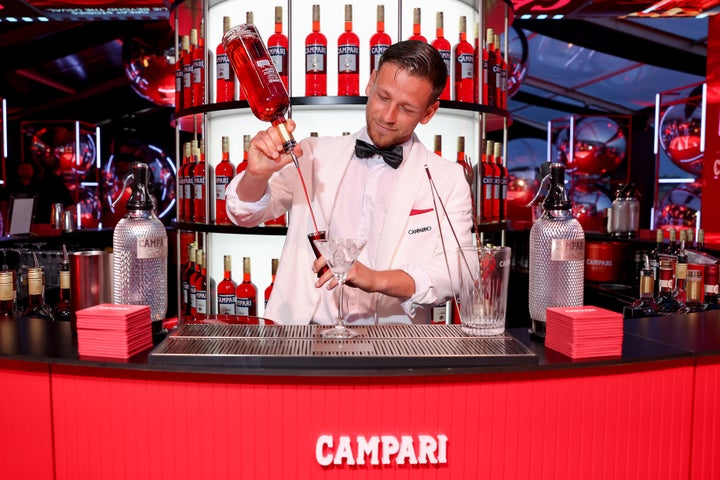The best type of gin to buy and the one ingredient you should splurge on.
The Negroni is a three-ingredient cocktail, made with equal parts gin, Campari and sweet vermouth. And according to Joshua Scheid, the bar manager of Rex at the Royal in Philadelphia, the recipe works really well as-is, but is also easy to tinker around with and execute at home.
There are a few keys to getting it right.
First, like any recipe, you have to start with high-quality ingredients.
Gin
The world of gin is wide, with varying botanicals and spices, but the traditional type of gin used in a Negroni is London dry, known for its piney flavor profile.
“Because the other ingredients, especially the Campari, are bombastic, I think you need the heavy juniper presence to make that gin stand up,” said Sean Umstead, co-owner of Kingfisher in Durham, NC. “So for me it’s Beefeater or Tanqueray that just really shines in the Negroni.”
Of course, it’s all a matter of preference. Scheid, for example, prefers to use American gins. “I find that they tend to be a little bit more adventurous in the botanicals. And whenever possible, I like using local stuff, both in my home bar and behind the bar where I work,” he said. For the Philly-based cocktail pro, that’s Bluecoat Gin — but wherever you’re located, a local gin is going to give the cocktail a sense of place.
Campari
This one is inflexible — it’s not a Negroni without Campari. The brilliant red Italian liqueur is an aperitif made with a blend of spices and herbs and gives the Negroni its bitterness.
“It’s the bright grapefruit, orangey, bitter component that gives the drink that … quenches-your-thirst kind of thing,” Umstead said. While Campari is generally thought of as an aperitif, Umstead believes it can be enjoyed any time —it’s bitter and sweet, and it’s boozier than other aperitifs.

If you do want to experiment with a substitution, Scheid likes to use Faccia Brutto’s aperitivo. The Brooklyn-based brand’s liqueur hearkens to Campari with its red hue and bitterness, but incorporates orange peels, giving it a really citrusy flavor.
Vermouth
Vermouth is one Negroni ingredient worth splurging on, Scheid said. “Because for me, what really makes a Negroni so excellent is the sort of luxurious richness of it. And that’s what you get from the sweet vermouth specifically,” Scheid said. An option that exemplifies that richness is Carpano Antica Formula, a sweet Italian vermouth, he added.
Melissa Watson, the self-proclaimed “Negroni Queen” who works at Bitters & Bottles in South San Francisco, particularly enjoys sipping a Negroni in the afternoon. While some might play around with the ratios of the components (i.e. bump up the amount of gin to make it a little boozier), she likes to keep them equal. “That means the vermouth has to keep up its part of the equation,” Watson said. One vermouth that she’ll reach for is Cocchi Vermouth di Torino, which has a nice earthiness to it, she explained. “I like a pretty earthy, good sense of bittersweetness in my vermouth,” she said.
A vermouth that Watson doesn’t like in her Negroni, though? Dolin Rouge, a red vermouth that’s just too light-bodied for her taste.
Technique
Once you have your spirits selected, it’s time to make the drink. Because the Negroni is a drink made with just alcohol (no juice or syrups), it’s stirred, never shaken. “Stirring preserves the integrity of the oil content in the spirits,” Scheid said. “So that results in a more rich, silky mouthfeel that coats your mouth as it goes in. And that’s really what you want from a Negroni.”
Stir the ingredients in a glass — you could get fancy and use a cocktail mixing glass, if you’d like, but any glass will do. Pour in the spirits in equal parts and add ice so that it’s above the line of the liquid. “Then use a spoon ― the bartender technique is you keep the back of the spoon flush against the mixing vessel ― and spin that around so that the back of the spoon is always in contact with the inside of the glass,” Scheid explained. “You aren’t really agitating the ice back and forth, the ice is its own kind of sculpture that’s rotating in entirety through the liquid.” Then you’ll strain it into a glass with ice. You could use the ice in your freezer, but an ice cube tray will make uniform cubes or bigger cubes that will take less time to melt, so there’s less time to dilute your drink.
Watson will also sometimes build the Negroni in the glass she’s drinking it from. Put the ice and ingredients in the drinking glass, stir, and let it sit for a moment to dilute and chill. “It feels special, but it doesn’t have to be fussy. You can just fill a glass with ice and pour,” Watson said.
Don’t forget to garnish the drink with an orange peel. Use a peeler or a paring knife to cut off some peel (try not to get the pith) and then express the orange oil over the drink. “Expressing” sounds fancy, but all you’re doing is squeezing the peel over the drink so that oils drop on top. Rub it around the rim of the glass and then plop it in the drink.
Credit: Source link